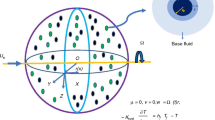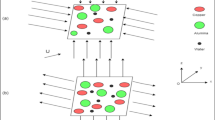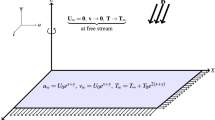Abstract
The interfacial nanolayer is a tinny coating of liquid molecules convened around the immersed solid nanoparticles in the base liquid, and it promises a vibrant role in improving and controlling the thermal properties of the nanoparticles and flow features when embedded in the base fluid. Hence, the current study features the effect of interfacial nanolayer thickness during MWCNT and nanodiamonds (ND) embedded water-based hybrid nanofluid fluid over an inclined stretching cylinder. Nonlinear Arrhenius activation energy, binary chemical reactions and Cattaneo-Christov heat flux are included in the system. An appropriate transition is applied to rationalize the substantially paired and nonlinear governing equations and then processed by the Galerkin finite element method (G-FEM). The impression of different governing parameters on the governing systems in conjunction with entropy and Bejan number is demonstrated through graphical and tabular form. The graphs are drawn with an evaluation of general and hybrid nanofluids and different nanolayer thicknesses of nanoparticles. Three-dimensional features were observed for skin friction, heat, and mass transfer. The effects of entropy and the Bejan number are exhibited through graphs. The thermal impact is very significant in the presence of Cattaneo-Christov heat flux and is further supported by nonlinear thermal radiation and the Brinkman number. It is true that the Brinkman number disrupts the heat transfer rate; however, it improves with heat generation. Entropy generation is enhanced with an enhancement in permeability.
Graphical Abstract



































Similar content being viewed by others
Data Availability Statement
This manuscript has associated data in a data repository. [Authors’ comment: Data will be available on request].
Abbreviations
- \((u,w)\) :
-
Velocity components in \(\left( {r,\,\,z} \right)\) directions
- \(\left( {\rho C_{p} } \right)_{nf}\) :
-
Heat capacitance of nanofluid
- \(\left( {\rho C_{p} } \right)_{f}\) :
-
Effective heat capacitance of base fluid
- \(\left( {\rho C_{p} } \right)_{s}\) :
-
The effective heat capacitance of nanoparticles
- \(\rho_{s}\) :
-
Density of nanoparticles
- \(\rho_{f}\) :
-
Density of base fluid
- \(\mu_{nf}\) :
-
Dynamic viscosity of nanofluid
- \(\mu_{f}\) :
-
Dynamic viscosity of base fluid
- \(k_{nf}\) :
-
Thermal conductivity of nanofluid
- \(k_{f}\) :
-
Thermal conductivity of base fluid
- \(k_{s}\) :
-
Thermal conductivity of nanoparticles
- \(\sigma_{nf}\) :
-
Electrical conductivity of nanofluid
- \(\sigma_{s}\) :
-
Electrical conductivity of nanoparticles
- \(\sigma_{f}\) :
-
Electrical conductivity of base fluid
- \(\mu_{hnf}\) :
-
Effective dynamic viscosity of hybrid nanofluid
- \(\rho_{hnf}\) :
-
Density of hybrid nanofluid
- \(\left( {\rho c_{p} } \right)_{hnf}\) :
-
Heat capacitance of hybrid nanofluid
- \(\sigma_{hnf}\) :
-
Electrical conductivity of hybrid nanofluid
- \(\left( {\rho \beta } \right)_{hnf}\) :
-
Thermal expansion of hybrid nanofluid
- \(K_{T}\) :
-
Thermal diffusion ratio
- \(T\) :
-
The fluid temperature \(\left( K \right)\)
- \(\sigma_{SB}\) :
-
Stefan Boltzmann constant
- \(m_{a}\) :
-
Mean absorption coefficient
- \(\Gamma\) :
-
Curvature parameter
- Rd:
-
Radiation parameter
- \(R_{T}\) :
-
Thermal relaxation parameter
- \(P_{r}\) :
-
Prandtl number
- \(Sc\) :
-
Schimdt number
- \({\text{Re}}_{L}\) :
-
Local Reynolds number
- \(\Pr\) :
-
Prandtl number
- \(D_{m}\) :
-
Solutal diffusivity
- \(Sr\) :
-
Soret number
- \(D_{f}\) :
-
Dufour number
- \(Bi_{1}\) :
-
Thermal Biot number
- \(L^{*}\) :
-
Diffusion parameter
- \(E_{1}\) :
-
Activation energy
- \(K_{1}\) :
-
Chemical reaction parameter
- \(a\) :
-
Radius of the cylinder
- \(L\) :
-
Reference length
- \(Br\) :
-
Brinkman number
- \(\Upsilon\) :
-
Casson parameter
- \(\phi_{1} ,\,\phi_{2}\) :
-
Original solid volume fraction
- \(I_{1} ,\,I_{2}\) :
-
Ratio of nanolayer
- \(\varphi _{1} ,\;\varphi _{2}\) :
-
Upgraded volume fractions
- \(M\) :
-
Magnetic parameter
- \(Q\) :
-
Heat generation parameter
- \(\theta_{f}\) :
-
Temperature ratio parameter
- \(Gr\) :
-
Thermal Grashof number
- \(Gc\) :
-
Solutal Grashof number
- \(Bi_{2}\) :
-
Solutal Biot number
References
G. Mahanta, S. Shaw, 3D Casson fluid flow past a porous linearly stretching sheet with convective boundary condition. Alex. Eng. J. 54, 653–659 (2015). https://doi.org/10.1016/j.aej.2015.04.014
D. Das, S. Shaw, K.K. Mondal, R.R. Kairi, Analyzing the impact of boundary slip and absorption effects on the dispersion of solute in a pulsatile channel flow of Casson fluid under magnetic field. Eur. Phys. J. Plus 138(5), 372 (2023). https://doi.org/10.1140/epjp/s13360-023-03973-8
T. Makayssi, M. Lamsaadi, M. Kaddiri, Y. Tizakast, Effect of an ascendant magnetic field on Rayleigh-Bénard convection for non-Newtonian power-law fluids in a horizontal rectangular cavity submitted to vertical temperature gradient. Eur. Phys. J. Plus 138(7), 650 (2023). https://doi.org/10.1140/epjp/s13360-023-04290-w
K. Pushpalatha, J.R. Reddy, V. Sugunamma, N. Sandeep, Numerical study chemically reacting unsteady Casson fluid flow past a stretching surface with cross-diffusion and thermal radiation. Open Eng. 7, 69–76 (2017). https://doi.org/10.1515/eng-2017-0013
M. Das, G. Mahanta, S. Shaw, Heat and mass transfer effect on an unsteady MHD Radiative Chemically reactive Casson fluid over a stretching sheet in a porous medium. Heat Trans. 49, 4350–4369 (2020). https://doi.org/10.1002/htj.21830
J. Ba, Z. Fang, L.Y. Fu, W. Xu, L. Zhang, Acoustic wave propagation in a porous medium saturated with a Kelvin-Voigt non-Newtonian fluid. Geophysical J. Int. 235(3), 2056–2077 (2023). https://doi.org/10.1093/gji/ggad355
S.U.S. Choi, J.A. Eastman, Enhancing thermal conductivity of fluids with nanoparticles. Argonne National Lab 84938, 951135–951229 (1995)
H. Xie, H. Lee, W. Youn, M. Choi, Nanofluids containing multiwalled carbon nanotubes and their enhanced thermal conductivities. J. Appl. Phys. 94(8), 4967–4971 (2003). https://doi.org/10.1063/1.1613374
K.K. Asogwa, K.T. Kumar, B.S. Goud, J.S. Chohan, Significance of nanoparticle shape factor and buoyancy effects on a parabolic motion of EMHD convective nanofluid past a Riga plate with ramped wall temperature. Euro. Phys. J. Plus 138(6), 1–13 (2023). https://doi.org/10.1140/epjp/s13360-023-04170-3
G. Mahanta, S. Mohanta, D. Mohanty, Stability and Convergence Analysis of Casson-nano Fluid Flow is Heated Non-linearly with Viscous Dissipation with Convective Boundary Conditions. Int. J. Appl. Eng. Res. 17(3), 290–298 (2022). https://doi.org/10.37622/IJAER/17.3.2022.290-298
D. Ramya, R.S. Raju, J.A. Rao, A.J. Chamkha, Effects of velocity and thermal wall slip on magnetohydrodynamics (MHD) boundary layer viscous flow and heat transfer of a nanofluid over a non-linearly-stretching sheet: a numerical study. Prop. Power Res. 7, 182–195 (2018). https://doi.org/10.1016/j.jppr.2018.04.003
S.P.A. Devi, S.S.U. Devi, Numerical investigation of hydromagnetic hybrid Cu–Al2O3/water nanofluid flow over a permeable stretching sheet with suction. Int. J. Nonlinear Sci. Numeri. Simul. 17, 249–257 (2016). https://doi.org/10.1515/ijnsns-2016-0037
M.M. Bhatti, H.F. Öztop, R. Ellahi, I.E. Sarris, M.H. Doranehgard, Insight into the investigation of diamond (C) and Silica (SiO2) nanoparticles suspended in water-based hybrid nanofluid with application in solar collector. J. Mol. Liq. 357, 119134 (2022). https://doi.org/10.1016/j.molliq.2022.119134
P.K. Ratha, R.S. Tripathy, S.R. Mishra, Particle-shape illustration via the Hamilton-Crosser and Yamada-Ota hybrid nanofluid flow models past a stretching cylinder. Eur. Phys. J. Plus 138(2), 1–15 (2023). https://doi.org/10.1140/epjp/s13360-023-03752-5
S.E. Awan, M. Awais, M.A.Z. Raja, S.U. Rehman, C.M. Shu, Bayesian regularization knack-based intelligent networks for thermo-physical analysis of 3D MHD nanofluidic flow model over an exponential stretching surface. Eur. Phys. J. Plus 138(1), 2 (2023). https://doi.org/10.1140/epjp/s13360-022-03607-5
I. Waini, U. Khan, A. Zaib, A. Ishak, I. Pop, Inspection of TiO2-CoFe2O4 nanoparticles on MHD flow toward a shrinking cylinder with radiative heat transfer. J. Mol. Liq. 361, 119615 (2022). https://doi.org/10.1016/j.molliq.2022.119615
T.A. Yusuf, M.B. Ashraf, F. Mabood, Cattaneo-Christov heat flux model for three-dimensional magnetohydrodynamic flow of an Eyring Powell fluid over an exponentially stretching surface with convective boundary condition. Numeri. Meth. Partial Differ. Equations 39(1), 242–253 (2023). https://doi.org/10.1002/num.22874
M. Hamid, M. Usman, Z. Tian, Computational analysis for fractional characterization of coupled convection-diffusion equations arising in MHD flows. Appl. Math. Mech. 44(4), 669–692 (2023). https://doi.org/10.1007/s10483-023-2970-6
B.K. Sharma, R. Gandhi, T. Abbas, M.M. Bhatti, Magnetohydrodynamics hemodynamics hybrid nanofluid flow through inclined stenotic artery. Appl. Math. Mech. 44(3), 459–476 (2023). https://doi.org/10.1007/s10483-023-2961-7
K. Hsiao, Micropolar nanofluid flow with MHD and viscous dissipation effects towards a stretching sheet with the multimedia feature. Int. J. Heat Mass Trans. 112, 983–990 (2017). https://doi.org/10.1016/j.ijheatmasstransfer.2017.05.042
D. Mohanty, G. Mahanta, S. Shaw, M. Das, Thermosolutal Marangoni stagnation point GO–MoS2/water hybrid nanofluid over a stretching sheet with the inclined magnetic field. Int. J. Modern Phys. B, 2450024 (2023). https://doi.org/10.1142/S0217979224500243
S. Shaw, A.S. Dogonchi, M.K. Nayak, O.D. Makinde, Impact of entropy generation and nonlinear thermal radiation on Darcy-Forchheimer flow of MnFe2O4-Casson/water nanofluid due to a rotating disk: Application to brain dynamics. Arabian J. Sci. Eng. 45(7), 5471–5490 (2020). https://doi.org/10.1007/s13369-020-04453-2
S. Mondal, N.A. Haroun, P. Sibanda, The effects of thermal radiation on an unsteady MHD axisymmetric stagnation-point flow over a shrinking sheet in presence of temperature dependent thermal conductivity with Navier slip. PLoS ONE 10(9), 0138355 (2015). https://doi.org/10.1371/journal.pone.0138355
T.R. Mahapatra, D. Pal, S. Mondal, Mixed convection flow in an inclined enclosure under magnetic field with thermal radiation and heat generation. Int. Comm. Heat Mass Trans. 41, 47–56 (2013). https://doi.org/10.1016/j.icheatmasstransfer.2012.10.028
I.S. Oyelakin, S. Mondal, P. Sibanda, Unsteady mixed convection in nanofluid flow through a porous medium with thermal radiation using the Bivariate Spectral Quasi linearization method. J. Nanofluids 6(2), 273–281 (2017). https://doi.org/10.1166/jon.2017.1310
A. Ishak, Thermal boundary layer flow over a stretching sheet in a micropolar fluid with radiation effect. Meccanica 45, 367–373 (2010). https://doi.org/10.1007/s11012-009-9257-4
S.S.S. Sen, M. Das, R. Mahato, S. Shaw, Entropy analysis on nonlinear radiative MHD flow of Diamond-Co3O4/ethylene glycol hybrid nanofluid with catalytic effects. Int. Comm. Heat Mass Trans. 129, 105704 (2021). https://doi.org/10.1016/j.icheatmasstransfer.2021.105704
S.M. Hussain, Dynamics of radiative Williamson hybrid nanofluid with entropy generation: significance in solar aircraft. Sci. Reports 12(1), 8916 (2022). https://doi.org/10.1038/s41598-022-13086-4
D. Mohanty, G. Mahanta, S. Shaw, Analysis of irreversibility for 3-D MHD convective Darcy-Forchheimer Casson hybrid nanofluid flow due to a rotating disk with Cattaneo-Christov heat flux, Joule heating, and nonlinear thermal radiation. Numeri. Heat Transf. B: Fund. 84(2), 115–142 (2023). https://doi.org/10.1080/10407790.2023.2189644
M.K. Nayak, F. Mabood, A.S. Dogonchi, K.M. Ramadan, I. Tlili, W.A. Khan, Entropy optimized assisting and opposing non-linear radiative flow of hybrid nanofluid. Waves Random Comp. Media, 1–22 (2022). https://doi.org/10.1080/17455030.2022.2032474
H.F. Jiang, H. Li, Q.H. Xu, Effective thermal conductivity of nanofluids considering interfacial nano-shells. Mater. Chem. Phys. 148, 195–200 (2014). https://doi.org/10.1016/j.matchemphys.2014.07.031
M.M. Heyhat, A. Rajabpour, M. Abbasi, S. Arabha, Importance of nanolayer formation in nanofluid properties: Equilibrium molecular dynamic simulations for Ag-water nanofluid. J. Mol. Liq. 264, 699–705 (2018). https://doi.org/10.1016/j.molliq.2018.05.122
I. Mitiche, O. Lamrous, S. Makhlouf, Effect of the interface layer vibration modes in enhancing thermal conductivity of nanofluids. Phys. Rev. E 100(4), 042120 (2019). https://doi.org/10.1103/PhysRevE.100.042120
J.H. Chen, K. Han, S. Wang, Investigation of enhanced thermal properties of Cu Ar nanofluids by reverse non equilibrium molecular dynamics method. Powder Technol. 356, 559–565 (2019). https://doi.org/10.1016/j.powtec.2019.08.051
S. Zeroual, H. Loulijat, E. Achehal, Viscosity of Ar-Cu nanofluids by molecular dynamics simulations: effects of nanoparticle content, temperature and potential interaction. J. Mol. Liq. 268, 490–496 (2018). https://doi.org/10.1016/j.molliq.2018.07.090
W. Yu, S. Choi, The role of interfacial layers in the enhanced thermal conductivity of nanofluids: a renovated maxwell model. J. Nanoparticle Res. 5, 167–171 (2003). https://doi.org/10.1023/A:1024438603801
J.R. Henderson, F. Van Swol, On the interface between a fluid and a planar wall: theory and simulations of a hard sphere fluid at a hard wall. Mol. Phys. 51, 991–1010 (1984). https://doi.org/10.1080/00268978400100651
A. Khodayari, M. Fasano, M.B. Bigdeli, S. Mohhamadnejad, E. Chiavazzo, P. Asinari, Effect of interfacial thermal resistance and nanolayer on estimates of effective thermal conductivity of nanofluids. Case Stud. Ther. Eng. 12, 454–461 (2018). https://doi.org/10.1016/j.csite.2018.06.005
Y. Li, Y. Zhai, M. Ma, Z. Xuan, H. Wang, Using molecular dynamics simulations to investigate the effect of the interfacial nanolayer structure on enhancing the viscosity and thermal conductivity of nanofluids. Int. Comm. Heat Mass Trans. 122, 105181 (2021). https://doi.org/10.1016/j.icheatmasstransfer.2021.105181
C. Gerardi, D. Cory, J. Buongiorno, L.W. Hu, T. Mckrell, Nuclear magnetic resonance-based study of ordered layering on the surface of alumina nanoparticles in water. Appl. Phys. Lett. 95(25), 253104 (2009). https://doi.org/10.1063/1.3276551
C. Hu, M. Bai, J. Lv, P. Wang, L. Zhang, X. Li, Molecular dynamics simulation of nanofluid’s flow behaviors in the near-wall model and main flow model. Microfluidics nanofluidics 17, 581–589 (2014). https://doi.org/10.1007/s10404-013-1323-5
L. Li, Y. Zhang, H. Ma, M. Yang, Molecular dynamics simulation of effect of liquid layering around the nanoparticle on the enhanced thermal conductivity of nanofluids. J. Nanoparticle Res. 12, 811–821 (2010). https://doi.org/10.1007/s11051-009-9728-5
S. Sarkar, R.P. Selvem, Molecular dynamics simulation of effective thermal conductivity and study of enhanced thermal transport mechanism in nanofluids. J. Appl. Phys. 102, 074602 (2007). https://doi.org/10.1063/1.2785009
W. Fan, F. Zhong, Effects of macroparameters on the thickness of an interfacial nanolayer of Al2O3− and TiO2−water-based nanofluids. ACS Omega 5, 27972–27977 (2020). https://doi.org/10.1021/acsomega.0c03452
A.A. Gkountas, L.T. Benos, G.N. Sofiadis, I.E. Sarris, A printed-circuit heat exchanger considering by exploiting an Al2O3-water nanofluid: Effect of the nanoparticles interfacial layer on heat transfer. Ther. Sci. Eng. Prog. 22, 100818 (2021). https://doi.org/10.1016/j.tsep.2020.100818
P. Tillman, J.M. Hill, Determination of nanolayer thickness for a nanofluid. Int. Comm. Heat Mass Trans. 34(4), 399–407 (2007). https://doi.org/10.1016/j.icheatmasstransfer.2007.01.011
R. Kumar, T. Sharma, K. Vajravelu, Melting heat transport in a mixed convective squeeze flow of a hybrid nanofluid with interfacial nanolayer effects. Z. Angew. Math. Mech. 103(3), e202200092 (2023). https://doi.org/10.1002/zamm.202200092
H. Jiang, Q. Xu, C. Huang, L. Shi, The role of interfacial nanolayer in the enhanced thermal conductivity of carbon nanotube-based nanofluids. Appl. Phys. A 118, 197–205 (2015). https://doi.org/10.1007/s00339-014-8902-5
R.P. Gowda, R.N. Kumar, U. Khan, B.C. Prasannakumara, A. Zaib, A. Ishak, A.M. Galal, Dynamics of nanoparticle diameter and interfacial layer on flow of non-Newtonian (Jeffrey) nanofluid over a convective curved stretching sheet. Int. J. Modern Phys. B 36(31), 2250224 (2022). https://doi.org/10.1142/S0217979222502241
T. Hayat, Y. Saeed, S. Asad, A. Alsaedi, Convective heat and mass transfer in flow by an inclined stretching cylinder. J. Mol. Liq. 220, 573–580 (2016). https://doi.org/10.1016/j.molliq.2016.03.047
Z. Abdelmalek, S.U. Khan, H. Waqas, A. Riaz, I.A. Khan, I.A. Tlili, A Mathematical model for bioconvection flow of Williamson nanofluid over a stretching cylinder featuring variable thermal conductivity, activation energy and second-order slip. J. Ther. Anal Calorimetry 144, 205–217 (2021). https://doi.org/10.1007/s10973-020-09450-z
A.S. Butt, A. Ali, A. Mehmood, Numerical investigation of magnetic field effects on entropy generation in viscous flow over a stretching cylinder embedded in a porous medium. Energy 99, 237–249 (2016). https://doi.org/10.1016/j.energy.2016.01.067
S. Mandal, G.C. Shit, S. Shaw, O.D. Makinde, Entropy analysis of thermo- solutal stratification of nanofluid flow containing gyrotactic microorganisms over an inclined radiative stretching cylinder. Ther. Sci. Eng. Prog. 34, 101379 (2022). https://doi.org/10.1016/j.tsep.2022.101379
L. Schwartz, E.J. Garboczi, D.P. Bentz, Interfacial transport in porous media: Application to DC electrical conductivity of mortars. J. Appl. Phys. 78(10), 5898–5908 (1995). https://doi.org/10.1063/1.360591
K.C. Leong, C. Yang, S.M.S. Murshed, A model for the thermal conductivity of nanofluids—effect of interfacial layer. J. Nanoparticle Res. 8, 245–254 (2006). https://doi.org/10.1007/s11051-005-9018-9
H.Q. Xie, M. Fujii, X. Zhang, Effect of interfacial nanolayer on the effective thermal conductivity of nanoparticle-fluid mixture. Int. J. Heat Mass Trans. 48, 2926–2932 (2005). https://doi.org/10.1016/j.ijheatmasstransfer.2004.10.040
R. Kumar, T. Sharma, K. Vajravelu, Melting heat transport in a mixed convective squeeze flow of a hybrid nanofluid with interfacial nanolayer effects. Z. Angew. Math. Mech. 103, e202200092 (2023). https://doi.org/10.1002/zamm.202200092
D. Mohanty, N. Sethy, G. Mahanta, S. Shaw, Impact of the interfacial nanolayer on Marangoni convective Darcy-Forchheimer hybrid nanofluid flow over an infinite porous disk with Cattaneo-Christov heat flux. Ther. Sci. Eng. Prog. 41, 101854 (2023). https://doi.org/10.1016/j.tsep.2023.101854
J. Zhu, J. Cao, Effects of nanolayers and second order slip on unsteady nanofluid flow past a wedge. Mathematics 7, 1043 (2019). https://doi.org/10.3390/math7111043
Acknowledgements
Authors’ thanks are due to Professor Mike Taylor, University of Central Florida, Orlando, Florida 32816, USA, for editing the manuscript for better readability and English.
Funding
No funding information is available.
Author information
Authors and Affiliations
Corresponding author
Ethics declarations
Conflict of interest
The authors have no conflict of interest to disclose.
Rights and permissions
Springer Nature or its licensor (e.g. a society or other partner) holds exclusive rights to this article under a publishing agreement with the author(s) or other rightsholder(s); author self-archiving of the accepted manuscript version of this article is solely governed by the terms of such publishing agreement and applicable law.
About this article
Cite this article
Mohanty, D., Mahanta, G., Vajravelu, K. et al. Interfacial nanolayer mechanism and irreversibility analysis for nonlinear Arrhenius reactive hybrid nanofluid flow over an inclined stretched cylinder. Eur. Phys. J. Plus 138, 1150 (2023). https://doi.org/10.1140/epjp/s13360-023-04743-2
Received:
Accepted:
Published:
DOI: https://doi.org/10.1140/epjp/s13360-023-04743-2




